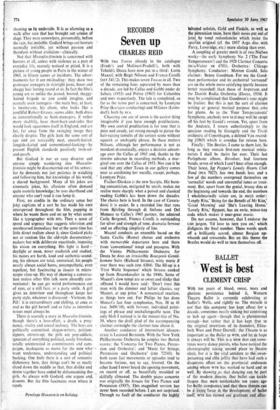Seven up
RECORDS CHARLES REID
With two Toscas already in the catalogue (Erede's and Molinari-Pradelli's, both with Tebaldi), Decca have now put in a third: Lorin Maazel, with Birgit Nilsson and Franco Corelli (SET 341/ 2). This makes seven Toscas in all. Two of the remaining four, separated by more than a decade, are led by Callas and Gobbi under de Sabata (1953) and Pretre (1965) for Columbia and HMV respectively. The tale is completed, so far as the name part is concerned, by Leontyne Price (Karajan conducting) and Milanov (Leins- dorf), both by RCA.
Choosing one out of seven is the easiest thing imaginable if you have enough predilections. My own central predilection is for tone that is pure and steady, yet strong enough to pierce the hair-raising tumults of the torture scene without squawk or unshapely phrase. In these matters Nilsson, although her performance is not as mordant dramatically, enjoys a decisive advant- age over the Callas of 1965 and, thanks to the interim advance in recording methods, a mar- ginal one over the Callas of 1953. Nor can it be said that any other Tosca in our gallery comes near to outshining her vocally, except, perhaps, Leontyne Price.
Fischer-Dieskau is the new Scarpia. His burn- ing romanticism, mitigated by snarls, makes me realise more sharply what a poised and classical reading Gobbi's has been down the decades. The choice here is hard. In the case of Cavara- dosi it is easier. In a recorded line that runs from Bleeding through di Stefano and Del Monaco to Callas's 1965 partner, the admired Carlo Bergonzi, Franco Corelli is outstanding for silver and strength of tone, dramatic fervour and an affecting simplicity of line.
Maazel condutts an ensemble based on the Santa Cecilia (Rome) chorus and orchestra with memorable departures here and there from 'conventional' tempi and pressures. With the Vienna Philharmonic Orchestra for Decca he does an irresistible Bourgeois Gentil- homme Suite (Richard Strauss), witty music if ever there was such (sxt. 6304). The fill-up is a `First Waltz Sequence' which Strauss cooked up from Rosenkavalier in the 1940s. Some of Maazel's slow tempi are so sweet and slinky that offhand I would have said : 'Don't trust this man with the slimmer and loftier classics, say Mozart, at any price.' A nonsensical reaction, as things turn out. For Philips he has done Mozart's last four symphonies, Nos. 38 to 41 (SAL 3609/10), with fervour, individual point- ings of phrase and unehallengeable taste. The only blob I noticed is in the minuet-trio of No. 39, where the droll plod of the accompanying clarinet outweighs the clarinet tune above it.
Another conductor of intermittent idiosyn, crasy is Leonard Bernstein. With the New York Philharmonic Orchestra he couples two Bartok scores: the 'Concerto for Two Pianos, Percus- sion and Orchestra'; and 'Music for Strings, Percussion and Orchestra' (cBs 72543). In' both cases fast movements or episodes tend to become furious, not to say, fevered. On the other hand I never heard the opening movement, on record or off, so beautifully moulded or skilfully climaxed. The double piano concerto was originally the Sonata for Two Pianos and Percussion (1937). This magnified version has never been recorded before. I am not surprise& Through no fault of the conductor the highly talented soloisis, Gold and Fizdale, as well as the percussion team, have their noses put out of joint, by tonal redundancies which make the sparian original_ (cf. the 1957 Argo. disc with Parry, Loveridge, etc.) more elating than ever.
A coupling of greater merit is of two Nielsen works—the early Symphony No. 2 ((The Four Temperaments') aqd the 1928 Clarinet Coracerto (RC/Victor sa 6701). Orchestra : Chicago Symphony. Conductor: Morton Gould, Solo clarinet: Benny Goodman. For me the Good- man performance and its orchestral 'surround' are on the whole more satisfying (partly because better recorded) than those of Jespersoo , and the Danish Radio Orchestra (Decca, 1954). It may be complained that Goodman's tone might be fruitier. But this is not the sort of clarinet writing or general musical purpose that ,asks for ,plums. As to the 'Four Temperarrients' Symphony, anybody new to it may well be swept off his feet by Gould's version. Yet, apart from the Andante, I return unhesitatingly to the spacious reading by Garaguly and the Tivoli orchestra of Copenhagen, a deleted Vox record- ing (1965) which is overdue for reissue here.
Finally: The Beatles. I cache to them late. So long as they remain first-rate musical minia- turists I shall be theirs for ever. Their last Parlpphone album, Revolver, had fourteen bands, seven of which I can't hear often enough. Their latest, Sgt Pepper's Lonely Hearts Club Band (Pcs 7027), has two bands less; and a few ,of the numbers overspread themselves on `surrealist' words and uneventful tunes or treat- ment. But, apart from the genial, brassy dins at the beginning and towards the end, the numbers. I wholeheartedly salute are, in merit order: `Lovely Rita,' Being for the Benefit of Mr Kite,' `Good Morning' and 'She's Leaving Home.' `Lovely Rita,' flippant, has an eerie, minor-key coda which makes it near-great music.
Do not assume, however, that I endorse the LSD jargon. 'I'd love to turn you on,'. which disfigures the final number. These words spark off a brilliantly scored, almost Bergian up- whoosh and crescendo. But on this theme the Beatles would do well to turn themselves off.










































 Previous page
Previous page